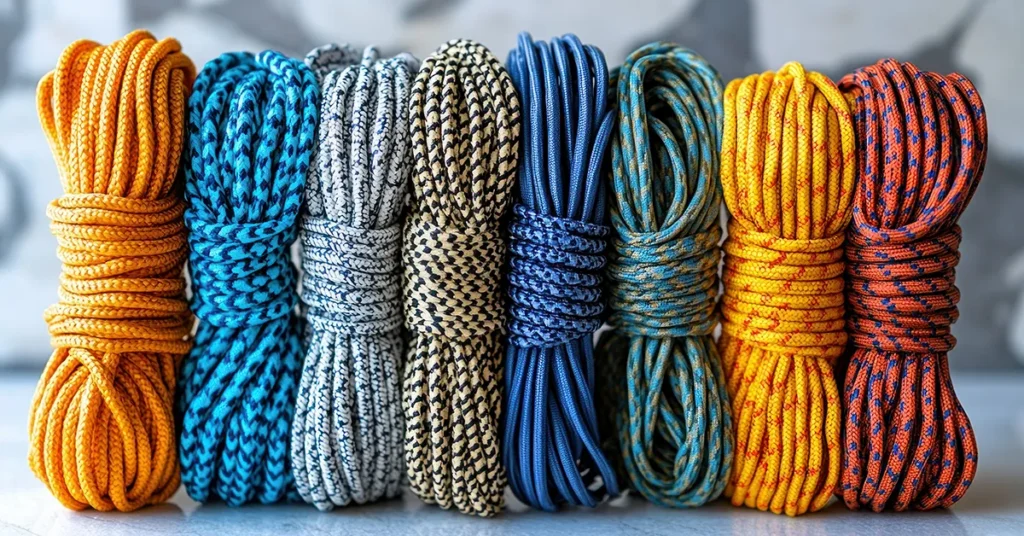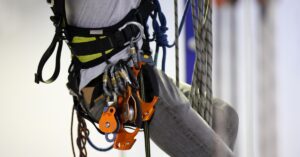When it comes to outdoor activities like climbing, rappelling, or rescue scenarios, choosing the right rope can mean the difference between a successful adventure and a dangerous mistake. Ropes may seem like simple tools, but understanding their specific types and purposes is essential to ensuring your safety and optimizing performance.
One of the most important distinctions to grasp is the difference between static and dynamic ropes. These two types of ropes are designed with unique characteristics, each tailored to specific tasks and conditions. Selecting the wrong type of rope for an activity could compromise both safety and efficiency, which is why knowing how they differ—and when to use each—is so important.
In this guide, we’ll break down everything you need to know about static and dynamic ropes. We’ll explain what they are, highlight their specific uses, and teach you how to distinguish between the two. Plus, we’ll compare their performance in activities like climbing, rappelling, and rescue operations to help you make an informed decision for your next outdoor adventure.
Whether you’re scaling a sheer cliff, navigating a technical descent, or executing a rescue mission, understanding the right rope to use is critical. Let’s dive in and explore the differences between static and dynamic ropes so you can approach your next challenge with confidence and preparedness.
What Are Static and Dynamic Ropes?
Before diving into specific applications, it’s important to understand what sets static and dynamic ropes apart. While they might look similar, their construction and purpose are vastly different, making each better suited to certain activities.
Static ropes are the workhorses of the rope world, offering strength and stability with minimal stretch. Dynamic ropes, on the other hand, are designed to flex and absorb shock, making them an essential tool for climbers facing the possibility of falls. Let’s explore each type of rope in more detail to help you make an informed choice for your next adventure.

What Is a Static Rope?
A static rope is specifically engineered for tasks that demand strength, stability, and minimal stretch. These ropes are designed to hold steady under tension, making them ideal for activities like rappelling, hauling, caving, and rescue operations.
Static ropes are typically made from durable synthetic materials like nylon or polyester and feature a tightly woven sheath for added abrasion resistance. The key characteristic of static ropes is their low elasticity, which ensures they won’t stretch significantly under load. This stability is especially important when lowering or raising heavy loads, as excessive stretch could make the process inefficient—or even unsafe.
Thanks to their durability and ability to maintain tension without significant movement, static ropes are a go-to choice for situations where precision and control are critical. However, their lack of stretch makes them unsuitable for activities like lead climbing, where absorbing dynamic forces is necessary for safety.

What Is a Dynamic Rope?
A dynamic rope is specifically designed for climbing and other activities where the risk of falls is present. What sets dynamic ropes apart is their ability to stretch under load, which helps absorb the shock of a fall and reduces the impact force on the climber and anchor system.
Dynamic ropes are constructed from high-performance nylon fibers that are engineered to elongate when subjected to sudden forces. This stretch not only protects climbers from harsh impacts but also reduces the likelihood of rope or gear failure during a fall. The elasticity is measured by a rope’s impact force rating, with lower ratings indicating better shock absorption.
In addition to climbing, dynamic ropes are commonly used for mountaineering and other scenarios where falls are a possibility. Their flexibility and stretch make them essential for any situation where safety depends on reducing the forces generated by a fall. However, because of this elasticity, dynamic ropes are not ideal for static tasks like hauling or rappelling, as they would stretch unnecessarily under load.
Key Differences between Static Rope and Dynamic Rope
Understanding the key differences between static and dynamic ropes is crucial for selecting the right tool for your activity. From their elasticity to their durability and ideal use cases, each rope type is uniquely suited to certain scenarios. Here’s a closer look at how they compare across three critical aspects: elasticity, strength, and use cases.
Elasticity and Stretch
One of the most important differences between static and dynamic ropes is their elasticity.
- Dynamic Ropes: Designed to stretch under load, dynamic ropes typically elongate 7-10% during normal use, with even more stretch during a significant fall. This elasticity allows them to absorb the impact force of a fall, reducing the stress placed on the climber, gear, and anchor system. For example, in a climbing fall, a dynamic rope can reduce impact force by up to 60% compared to a static rope, making it an essential choice for lead climbing or any activity where falls are possible.
- Static Ropes: In contrast, static ropes have minimal stretch, usually less than 5%, even under heavy loads. This rigidity makes them perfect for activities like rappelling, hauling, or rescue operations, where precision and stability are paramount. However, the lack of elasticity also means static ropes should never be used for situations where falls could occur, as they do not absorb shock and could lead to dangerous levels of force on the climber or anchor points.
Strength and Durability
Both static and dynamic ropes are strong, but their durability and ability to handle wear and tear differ based on their design.
- Static Ropes: Known for their high tensile strength, static ropes are ideal for bearing heavy loads over time, such as when lowering equipment or hauling gear. Their tightly woven sheath makes them highly resistant to abrasion, which is essential for withstanding rough surfaces like rock faces or sharp edges. Because they don’t stretch, they are less likely to degrade from repeated tension, giving them excellent longevity in static applications.
- Dynamic Ropes: While dynamic ropes are also strong and capable of handling falls, they are more prone to wear and tear when used for static loads or in abrasive conditions. The stretchy core that gives dynamic ropes their elasticity can degrade over time, especially with repeated exposure to sharp edges or heavy hauling. For this reason, dynamic ropes should be reserved for situations where their shock-absorbing properties are required, and users should inspect them regularly for signs of wear.
Use Cases: Climbing, Rappelling, and Rescue
Static and dynamic ropes excel in very different applications, and choosing the wrong type for an activity can lead to inefficiency—or worse, safety risks.
- Static Ropes: These ropes are the go-to choice for rappelling, hauling, and rescue operations. Their minimal stretch ensures stable descents and precise control when lowering or raising equipment or people. Static ropes are also favored in caving, as their durability allows them to withstand repeated contact with rough and wet surfaces.
Product Recommendation: Static Rope for Fire & Rescue
- Dynamic Ropes: For climbing, dynamic ropes are indispensable. Their ability to stretch under load absorbs the shock of a fall, reducing the risk of injury to the climber and strain on the anchor system. Whether it’s sport climbing, trad climbing, or mountaineering, dynamic ropes provide the safety and flexibility climbers need. However, because of their stretch, they are not suitable for rappelling or hauling tasks, where precision and stability are required.
Product Recommendation: Dynamic Rope for Climbing
How to Tell a Static Rope from a Dynamic Rope
Choosing the right rope for your activity starts with being able to identify whether it’s a static rope or a dynamic rope. While they may look similar at a glance, there are key differences in their physical characteristics and labeling that make it easy to determine their type. Here’s how to quickly and accurately identify which rope you’re working with.
Visual and Physical Characteristics
Static and dynamic ropes have distinct physical traits that can help you differentiate between them.
- Sheath Construction: Static ropes often have a tighter and firmer sheath compared to dynamic ropes, which gives them a stiffer feel. This is due to their design for durability and minimal stretch. Dynamic ropes, on the other hand, tend to feel more flexible and pliable because of their elastic core.
- Markings: Many ropes include color-coded markings to indicate their type and intended use. For instance, dynamic ropes often feature bold or bright patterns, while static ropes may have more subdued designs. While this isn’t a hard rule, it’s worth noting when inspecting ropes.
- Stretch Test: If you’re still unsure, a simple stretch test can offer clues. Pull on the rope with some force—dynamic ropes will visibly stretch under tension, while static ropes will remain rigid. Just be cautious not to use excessive force, as this could damage the rope.
Labeling and Certifications
For a definitive answer, check the rope’s labeling and certifications. These markings are standardized by reputable organizations to provide clear identification.
- UIAA and EN Standards: Most high-quality ropes are certified by the UIAA (International Climbing and Mountaineering Federation) or EN (European Norm) standards. Dynamic ropes will typically have a UIAA label that specifies they meet the standards for impact force and elongation, while static ropes will often be labeled with an EN 1891 certification for low-stretch ropes.
- Manufacturer Labels: Rope packaging or tags will usually specify whether the rope is static or dynamic. Look for terms like “dynamic climbing rope” or “static work rope” directly on the label. Many ropes also have this information printed along the length of the sheath for easy reference during use.
Choosing the Right Rope for Your Activity

Selecting the right rope is one of the most important decisions you’ll make when planning for climbing, rappelling, or other outdoor activities. With so many options on the market, it’s essential to assess your specific needs and balance performance with your budget. Here’s how to ensure you’re choosing the right rope for the job.
Assessing Your Needs
The first step in selecting the perfect rope is to evaluate the specific requirements of your activity. Consider factors like weight, stretch, durability, and environmental conditions to narrow down your options.
Type of Activity
- For climbing, you’ll want a dynamic rope certified by the UIAA for falls, as it absorbs shock and protects you during unexpected drops. Lead climbers, for example, should prioritize ropes with low impact force ratings to reduce strain on their body and gear.
- For rappelling, static ropes are ideal because they provide stability and minimal stretch, making it easier to control your descent.
- For canyoneering or activities in wet conditions, look for static or dynamic ropes with water-resistant coatings, as untreated ropes may lose strength or become heavy when wet.
Rope Diameter
- Thinner ropes (8-9.5 mm) are lightweight and suitable for alpine climbing or long multi-pitch routes where every ounce matters.
- Thicker ropes (10-11 mm) are more durable and better suited for heavy use, such as top-roping or industrial applications.
Environmental Factors
- If you’re climbing in a rocky or abrasive environment, choose a rope with a durable sheath to prevent damage.
- For cold or icy conditions, look for ropes with dry-treated sheaths and cores to maintain performance and safety.
Consult the Experts
- If you’re unsure about the best rope for your needs, consult with climbing guides, rescue professionals, or sales experts at reputable outdoor gear stores. They can help you identify the perfect rope based on your goals and experience level.
Budget vs. Performance
When shopping for ropes, it’s tempting to go for the cheapest option—but safety and functionality should always take precedence. Here’s how to strike the right balance:
- Static Ropes: These tend to be less expensive than dynamic ropes due to their simpler construction. If your primary activities involve rappelling, hauling, or rescue work, investing in a high-quality static rope will save you money while meeting your performance needs.
- Dynamic Ropes: While dynamic ropes are typically more expensive, their shock-absorbing qualities make them indispensable for climbing. For lead climbers, spending more on a dynamic rope with a good impact force rating and UIAA certification is well worth the cost.
- Balancing Needs and Budget: If you’re a beginner or engaging in a mix of activities, consider purchasing a versatile rope that balances performance and price. Additionally, look for sales or bundles that include accessories like rope bags or carabiners, which can add value to your purchase.
Ultimately, your safety is the most important consideration, so prioritize quality over cutting costs. Investing in the right rope for your activity not only enhances performance but also gives you peace of mind during your outdoor adventures.
Common Questions about Dynamic & Static Rope
The easiest way to determine whether a rope is static or dynamic is to check its labeling and certifications. Most ropes are marked with information about their type and intended use. Look for certifications such as the UIAA label for dynamic ropes or EN 1891 for static ropes.
If the labeling isn’t available, you can perform a quick stretch test. Pull the rope with moderate force:
- Dynamic ropes will noticeably stretch under tension due to their elastic core.
- Static ropes will remain firm with minimal elongation, as they’re designed for stability.
For top-rope climbing, a dynamic rope is generally the best choice. While the forces generated in top-roping are lower than those in lead climbing, a dynamic rope’s elasticity still provides a safer and more comfortable experience. It absorbs some of the shock if a climber falls or slips, protecting both the climber and the anchor system.
Make sure to choose a dynamic rope with a thicker diameter (10-11 mm), as it offers greater durability and is better suited to the repeated wear and friction that comes with top-rope climbing.
Yes, you can rappel with a dynamic rope, but it’s not the ideal choice. Dynamic ropes are designed to stretch under load, which can make rappelling more difficult and less predictable. The rope’s elasticity may cause you to bounce slightly during the descent, making it harder to maintain control.
If you do choose to rappel with a dynamic rope, ensure proper technique and use a suitable belay device to manage the stretch. However, for the best results and safety, it’s recommended to use a static rope for rappelling. Static ropes offer the stability and precision needed for a smooth, controlled descent.
Proper storage is key to extending the life of your rope. Follow these tips to ensure it stays in good condition:
- Avoid Direct Sunlight: UV exposure can weaken the rope fibers over time. Store your rope in a cool, dry place away from sunlight.
- Use a Rope Bag: A rope bag protects your rope from dirt, moisture, and abrasion. It also makes it easier to transport and prevents tangles.
- Keep It Dry: Moisture can degrade rope fibers, especially for untreated ropes. Allow your rope to dry completely before storing it if it gets wet.
- Inspect Regularly: Check your rope for signs of wear, such as fraying, flat spots, or discoloration. Retire your rope if you notice significant damage or if it has exceeded its recommended lifespan.
Elongation refers to the amount a rope stretches under load. This property is a key difference between static and dynamic ropes:
- Static Ropes: Have low elongation, typically less than 5%, which ensures minimal stretch and maximum stability for tasks like rappelling and hauling.
- Dynamic Ropes: Have higher elongation, often ranging from 7-10%, allowing them to absorb shock during falls and protect climbers from harsh impact forces.
Understanding elongation is crucial when selecting a rope for your activity, as it directly impacts performance and safety.
Not all nylon ropes are dynamic, but most dynamic ropes are made from nylon. Nylon’s inherent elasticity makes it an excellent material for dynamic ropes, which need to stretch under load.
However, static ropes can also be made from nylon, though their construction is designed to limit stretch. The difference lies in how the rope is manufactured:
- Dynamic Ropes: Use a nylon core designed to elongate.
- Static Ropes: Have a tightly woven sheath and core to minimize stretch.
When purchasing nylon rope, always check the labeling to determine whether it’s dynamic or static.
Making the Right Choice Between Static and Dynamic Ropes
Choosing between a static and dynamic rope comes down to understanding their differences and matching the rope to your specific activity. Static ropes provide strength, stability, and minimal stretch, making them ideal for tasks like rappelling, hauling, or rescue operations. Dynamic ropes, with their ability to absorb shock and reduce impact, are the go-to choice for climbing and fall protection.
When making your decision, consider the demands of your activity, your safety requirements, and your budget. Investing in the right rope not only ensures a successful adventure but also provides peace of mind knowing you’re well-prepared for any situation.
If you’re ready to find the perfect rope for your next outdoor challenge, check out our selection of high-quality ropes designed for every type of activity. Whatever your adventure, we’re here to help you gear up with confidence.




